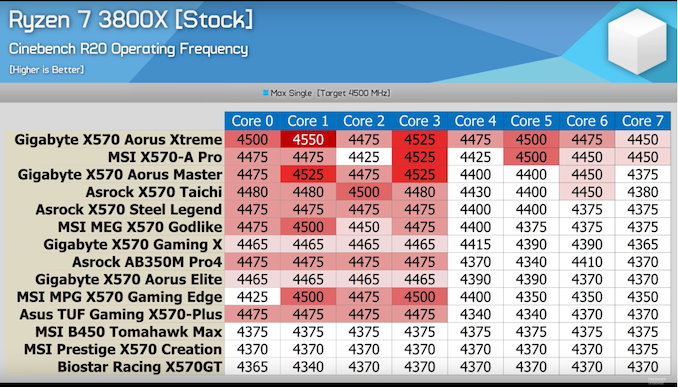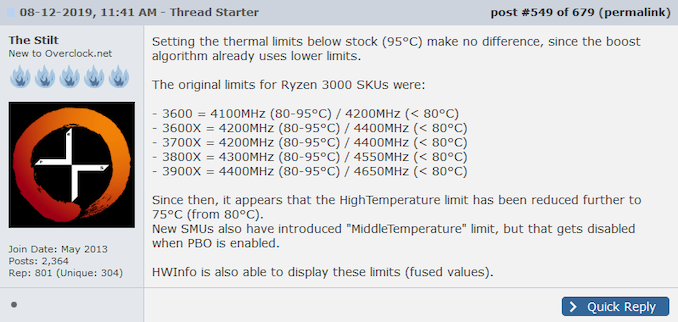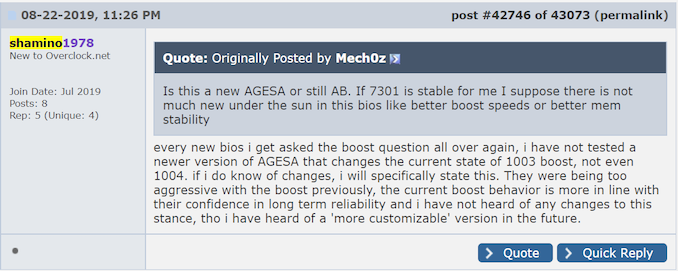Reaching for Turbo: Aligning Perception with AMD’s Frequency Metrics
by Dr. Ian Cutress on September 17, 2019 10:00 AM ESTAMD’s Turbo Issue (Abridged)
So why all this talk about how each company does its Turbo functionality, as well as its binning strategy? I prepped this story with the differences because a lot of our user base still thinks in terms of Intel’s way of doing things. Now that AMD is in the game and carving its own path, it’s important to understand AMD’s strategy in the context of the products coming out.
With that in mind, let’s cover AMD’s recent news.
Ever since the launch of Zen 2 and the Ryzen 3000 series CPUs, AMD has done its usual of advertising core counts, base frequency, TDP, and turbo frequencies. What has occurred since initial launch day reviews and through the public availability has been that groups of enthusiast users, looking to get the most out of their new shiny hardware, have reported that their processors are not hitting the turbo frequencies.
If a processor had a guaranteed 4.4 GHz turbo frequency, users were complaining that their peak turbo frequencies observed were 25-100 MHz less, or in some cases more than 100 MHz down on what was advertised. This kind of drop in frequency was being roughly reported through the ecosystem, but no-one particularly acted on it until these past few weeks, around the same time that AMD had several other news stories going on.
Multiple outlets, such as Hardware Unboxed, noted that the frequencies they were seeing significantly depended on the motherboard used. Hardware Unboxed tested 14 different AMD AM4 motherboards (some X570, others not X570) with a Ryzen 7 3800X, expecting a peak turbo frequency during Cinebench R20 of 4.5 GHz. Only one motherboard was consistent across most CPUs, while a few others were hit and miss.
This obviously plays into some reasoning that the turbo is motherboard dependent, all else being equal. It should be noted that there’s no guarantee that all these motherboards, despite being on the latest BIOSes, actually had AMD’s latest firmware versions in place.
Another outlet, Gamers Nexus, also observed that they could guarantee a CPU would hit its rated turbo speeds when the system was under some form of cold, either chilled water or a sub-zero cooling environment. This ultimately would lead some believe that this relates to a thermal capacity issue within the motherboard, CPU, or power delivery.
The Stilt, a popular user commonly associated with AMD’s hardware and its foibles, posted on 8/12 that AMD had reduced its peak temperature value for the Ryzen 3000 CPUs, and had introduced a middle temperature value to help guide the turbo. These values would be part of the SMU, or System Management Unit, that helps control turbo functionality.
Peter Tan, aka Shamino, a world renowned (retired) overclocker and senior engineer for ASUS’ motherboard division, acknowledged the issue in a forum post on 8/22 with his own take on the matter. He stated that AMD’s initial outlay with its turbo boost behavior was ultimately too aggressive, and in order to ensure longevity of the chip, the boost behavior was in line with what AMD needed to achieve that longevity.
It should be stated here that Shamino is speaking here in his personal capacity.
For those not engrained in the minutae of forum life, the biggest arrow to this issue came from Roman Hartung, or Der8auer, through his YouTube channel. He enlisted the help of his audience to tabulate what frequencies users were getting.
In the survey, the following details were requested:
- CPU
- Motherboard
- AGESA version/BIOS version
- PBO disabled
- Air cooling
Now obviously when it was announced that this survey was going to happen, Roman and AMD discussed behind the scenes the pros and cons about this survey. As you might expect, AMD had some reservations that this survey was in any way going to be fair – it’s about as unscientific as you can get. Naturally Roman argued that these would be real world results with users machines, rather than in-lab results, and AMD should be guaranteeing users on their home machines with specific frequency values. AMD also pointed out that with this sort of survey, you have an inherent selection bias: users who feel negatively impacted by any issue (through AMD’s fault or the users own) are more likely to respond than those that were happy with the performance. Roman agreed that this would be a concern, but still highlighted the fact that users shouldn’t be having these issues in the first place. AMD also mentioned that the Windows version couldn’t be controlled, to which Roman argued that if turbo is only valid for a certain Windows version, then it’s not fair to promote it, however did concede that the best performance was the latest version of Windows 10, and users on Windows 7 will have to accept some level of reduced performance.
Roman and AMD did at least agree on a testing scenario in order to standardize the reporting. Based on AMD’s recommendations, Roman requested from his audience that they use CineBench R15 as a single threaded load, and HWiNFO as the reporting tool, set to a 500 millisecond (0.5 second) polling interval, with the peak frequency from the CPU listed.
The survey ended up with ~3300 valid submissions, which Roman checked one-by-one to make sure all the data was present, screenshots showed the right values, and removed any data points that didn’t pass the testing conditions (such as PBO enabled). The results are explained in Roman’s video and the video is well worth a look. I’ve summarized the data for each CPU here.
| Der8auer's Ryzen Turbo Survey Results | |||||
| AnandTech | 3600 | 3600X | 3700X | 3800X | 3900X |
| Rated Turbo MHz of CPU | 4200 | 4400 | 4400 | 4500 | 4600 |
| Average Survey MHz | 4158 | 4320 | 4345 | 4450 | 4475 |
| Mode Survey MHz* | 4200 | 4350 | 4375 | 4475 | 4525 |
| Total Results Submitted | 568 | 190 | 1087 | 159 | 722 |
| # Results Minus Outliers | 542 | 180 | 1036 | 150 | 685 |
| Results >= Rated Turbo | 210 | 17 | 153 | 39 | 38 |
| % Results >= Rated Turbo | 50% | 9% | 15% | 26% | 6% |
| *Mode = most frequent result | |||||
I have corrected a couple of Roman’s calculations based on the video data, but they were minor changes.
For each CPU, we have the listed turbo frequency, the average turbo frequency from the survey, and the modal CPU frequency (i.e. the most frequently reported frequency). Beyond this, the number of users that reported a frequency equal to the turbo frequency or higher is listed as a percentage.
On the positive, the modal reported CPU frequency for almost all chips (except the 3900X) is relatively close, showing that most users are within 25-50 MHz of the advertised peak turbo frequency. The downside is that the actual number of users achieving the rated turbo is quite low. Aside from the Ryzen 5 3600, which is 50%, all the other CPUs struggle to see rated turbo speeds on the box.
As you might imagine, this data caused quite a stir in the community, and a number of vocal users who had invested hard earned money into their systems were agonizingly frustrated that they were not seeing the numbers that the box promised.
Before covering AMD’s response, I want to discuss frequency monitoring tools, turbo times, and the inherent issues with the Observer Effect. There’s also the issue of how long does turbo need to be active for it to count (or even register in software).













144 Comments
View All Comments
StrangerGuy - Wednesday, September 18, 2019 - link
Pretty much the only people left OCing CPUs are epeen wavers with more money than sense."$300 mobo and 360mm AIO for that Intel 8 core <10% OC at >200W...Look at all that *free* performance! Amirite?"
Korguz - Wednesday, September 18, 2019 - link
" Pretty much the only people left OCing CPUs are epeen wavers with more money than sense" that a pretty bold statement. i know quite a few people who overclock their cpus, because intel charged too much for the higher end ones, so they had to get a lower tier chip. with zen, thats not the case as much any more as they have switched over to amd, because by this time, they would of had to get a new mobo any way, because intels upgrade paths are only 2, maybe 3 years if they are lucky.dont " need " and AIO, as there are some pretty good air coolers out there, and some, dont like the idea of water, or liquid in their comps :-)
Xyler94 - Thursday, September 19, 2019 - link
Sorry, here's where I'll have to disagree with you.You'll never overclock an i3 to i5/i7 levels. If my choices were between an overclocking i3, with a Z series board, or a locked i5 with an H series board, I'd choose the i5 in a heartbeat, as that's just generally better. Overclocking will never make up the lack of physical cores.
So I agree, mostly these days overclocking is reserved for A: People with e-peens, and B:, people who genuinely need 5ghz on a single core... which are fewer than those who can utilize the multi-threaded horsepower of Ryzen... so yeah,
evernessince - Tuesday, September 17, 2019 - link
Does it deliver well? I see plenty of people on the Intel reddit not hitting advertised turbo speeds. That's considering they are using $50+ CPU coolers as well."Pretty impressive to see a server cpu with 20% lower ST performance only because the
low power process utilized is unable to deliver a clock speed near 4Ghz, absurd thing considering
that Intel 14nm LP gives 4GHz at 1V without struggles."
What CPU are you talking about? Even AMD's 64 core monster has damn near the same IPC as the Intel Xeon 8280 (thanks to Zen 2 IPC improvements) and that CPU has LESS THEN HALF THE CORES and only consumes 20w more. The Intel CPU also costs almost twice as much. Only a moron brings up single threaded performance in a server chip conversation anyways, it's one of the least important metric for server chips. AMD's new EPYC chip crushes Intel in Core count, TCO, power consumption, and security. Everything that is important to server.
yankeeDDL - Wednesday, September 18, 2019 - link
You do realize that the clock speed does not depend only by the process, right? Your comment sounds like that that of a disgruntled Intel fanboy trying to put AMD in under a bar light. For 25MHz.Spunjji - Monday, September 23, 2019 - link
Absolute codswallop. AMD are getting 100-300Mhz more on their peak clock speeds for Zen2 with this first-gen 7nm process tech than they were seeing with Zen+ 12nm (and nearly 400Mhz more than Zen on 14nm), so nothing about that implies that 7nm is slower than 14nm. Intel's architecture and process tech are not remotely comparable to AMD's, and we don't know what is the primary limiting factor on Zen clockspeeds.Not sure why you're claiming lower ST performance on the server parts either - Rome is better in every single regard than its predecessors, and it's better pound-for-pound than anything Intel will be able to offer in the next 12-18 months.
PeachNCream - Tuesday, September 17, 2019 - link
I see a tempest in a teapot on the stove of a person who is busy splitting hairs at the kitchen table. It would be more interesting to calculate how much energy and time was expended on the issue to see if the performance uplift from the fix will offset the global societal cost of all the clamoring this generated. For that, I suppose you'd have to know how many Ryzen chips are actually doing something productive as opposed to crunching at video games.The idea of buying cheaper hardware for non-work needs sticks here. Less investment means less worry about maximizing your return on your super-happy-fun-box and less heartburn over a little bit of clockspeed on a component that plays second fiddle to GPU performance when it comes to entertainment anyway.
psychobriggsy - Tuesday, September 17, 2019 - link
Ultimately in the end it isn't MHz that counts, it is observed performance in the software that you care about. That's why we read reviews, and why the review industry is so large.If performance X was good enough, does it matter if it was achieved at 4.5GHz or 4.425GHz? Not really. But if the CPU manufacturer is using it as a primary competitive comparison metric (rather than a comparative metric with their other SKUs) then it has to be considered, like in this article.
It is sad that MHz is still a major metric in the industry, although now Intel IPC is similar to AMD IPC, it is actually kinda relevant.
What I'd like is better CPU power draw measurements versus what the manufacturer says. Because TDP advertising seems to be even more fraught with lies/marketing than MHz marketing! Obviously most users don't care about 10 or 20% extra power draw at a CPU level, as at a system level it will be a tiny change, but it's when it is 100% that it matters.
IMO, I'd like TDPs to be reported at all core sustained turbo, not base clocks. Sure, have a typical TDP measurement as well as the more information the better, but don't hide your 200W CPU under a 95W TDP.
TechnicallyLogic - Tuesday, September 17, 2019 - link
Personally, I feel that AMD should have 2 numbers for the max frequency of the CPU; "Boost Clock" and "Burst Clock". Assuming that you have adequete cooling and power delivery, the boost clock would be sustainable indefinitely on a single core, while the burst clock would be the peak frequency that a single core on the CPU can reach, even if it's just for a few ms.fatweeb - Tuesday, September 17, 2019 - link
I could see them eventually going in this direction considering Navi already has three clocks: Base, Gaming, and Boost. The first two would be guaranteed, the last not so much.